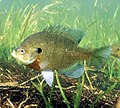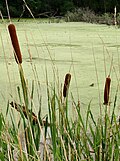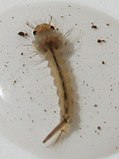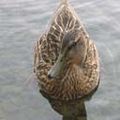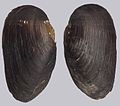Difference between revisions of "AY Honors/Ecology/Answer Key/es"
(Created page with "</noinclude> <!-- 2. Elegir un mamífero, un ave, un reptil y un anfibio de su ambiente familiar, y para cada uno construir un diagrama de su pirámide ecológica. --> File:...") |
(Created page with "</noinclude> ==Referencias== Category:Adventist Youth Honors Answer Book/es <noinclude>") |
||
| Line 229: | Line 229: | ||
{{CloseReq}} <!-- 9 --> | {{CloseReq}} <!-- 9 --> | ||
<noinclude></noinclude> | <noinclude></noinclude> | ||
| − | == | + | ==Referencias== |
| − | + | [[Category:Adventist Youth Honors Answer Book/es]] | |
| − | |||
| − | |||
| − | |||
| − | |||
<noinclude></noinclude> | <noinclude></noinclude> | ||
<section end="Body" /> | <section end="Body" /> | ||
Revision as of 18:55, 17 February 2021
| Ecología | ||
|---|---|---|
| Asociación General
|
Destreza: 2 Año de introducción: 1972 |
|
Requisitos
|
La especialidad de Ecología es un componente de la Maestría Conservación. |
| Conexión Logros para la Investidura: Esta especialidad está relacionada con los requisitos de Logros para la Investidura para GUÍA DE VIDA PRIMITIVA Estudio de la naturaleza que requiere (como una de dos opciones) una actividad que es similar al requisito #8 de esta especialidad. Esta especialidad es una elección popular para la especialidad de la categoría de Estudio de la naturaleza de nivel de destreza 2 o 3 requerido para los GUÍAS DE VIDA PRIMITIVA. |
1
Habitantes
¿Qué clases de vida puede sobrevivir en un estanque de agua dulce? Considere estos siguientes:
Árboles y arbustos. ¿Puede pensar en otros?
Hábitats
Hay cuatro hábitats distintos en un ecosistema de estanque de agua dulce:
- Capa superficial
- La capa de superficie es la parte superior de seis pulgadas de agua en la superficie del estanque. Este hábitat es donde existen muchos tipos de vida, incluyendo larvas de mosquitos, animales que respiran aire e insectos que pueden «caminar» en la superficie usando la tensión superficial. Sin embargo, la vida en la superficie no se limita al reino animal. También puede encontrar plantas flotantes y algas allí.
- Aguas abiertas
- peces, tortugas, plancton, fitoplancton, crustáceos
- Fondo
- Los animales que viven en el barro en el fondo de un estanque incluyen cangrejos de río, ninfas de libélula, rotíferos y bacterias. Estos animales se alimentan de materia orgánica muerta que llega hasta el fondo.
- Orilla
- En la orilla de un estanque se encuentran muchas plantas. Algunas de estas plantas crecen en la orilla, Otras crecen en el agua y otras crecen en ambos lugares. Algunas plantas tendrán raíces bajo el agua, pero tallos, hojas y flores por encima de la superficie. Otros crecerán completamente bajo el agua.
2

Una pirámide ecológica (o pirámide trófica) es una representación gráfica diseñada para mostrar la biomasa o la productividad en cada nivel trófico en un ecosistema dado. Las pirámides de la biomasa muestran la abundancia o la biomasa de los organismos en cada nivel trófico, mientras que las pirámides de la productividad muestran la producción o la vuelta en la biomasa. Las pirámides ecológicas comienzan con los productores en la parte inferior y avanzan a través de los varios niveles tróficos, el más alto de los cuales está encima.
3
3a
The science of the relationships between organisms and their environments.
3b
Refers to the organisms (plants and animals) in an ecosystem
3c
Describes the feeding relationships between species in an ecological community. They graphically represent the transfer of material and energy from one species to another within an ecosystem. Organisms are connected to the organisms they consume by arrows representing the direction of biomass transfer.
3d
Describes a relationship between two living organisms where one benefits and the other is neither harmed nor helped.
3e
A fundamental concept in ecology, refers to more-or-less predictable and orderly changes in the composition or structure of an ecological community.
3f
Plankton are any drifting organism that inhabits the water column of oceans, seas, and bodies of fresh water. They are widely considered to be some of the most important organisms on Earth, due to the food supply they provide to most aquatic life.
3g
The science of analyzing and protecting Earth's biological diversity. Conservation biology draws from the biological, physical and social sciences, economics, and the practice of natural-resource management.
3h
The term climax community is a largely obsolete ecological term for a biological community of plants and animals which, through the process of ecological succession - the development of vegetation in an area over time - has reached a steady state. Support among ecologists for the climax theory declined, because they found the theory with its many coined terms difficult to apply, because they were dissatisfied how it compared to observed individual organisms, and because better theories developed. Despite the overall abandonment of climax theory, during the 1990s use of climax concepts again became more popular among some theoretical ecologists. Many authors and nature-enthusiasts continue to use the term "climax" in a diluted form to refer to what might otherwise be called mature or old-growth communities.
3i
Eutrophication refers to an increase in the primary productivity of any ecosystem. It is caused by the increase of chemical nutrients, typically compounds containing nitrogen or phosphorus. It may occur on land or in water. In aquatic environments, enhanced growth of choking aquatic vegetation or phytoplankton (that is, an algal bloom) disrupts normal functioning of the ecosystem, causing a variety of problems.
3j
A biome is a major class of ecologically similar communities of plants, animals, and soil organisms, often referred to as ecosystems. Biomes are defined based on factors such as plant structures (such as trees, shrubs, and grasses), leaf types (such as broadleaf and needleleaf), plant spacing (forest, woodland, savanna), and other factors like climate. Unlike ecozones, biomes are not defined by genetic, taxonomic, or historical similarities. Biomes are often identified with particular patterns of ecological succession and climax vegetation.
4
The choice of an animal to study is totally up to you. You may wish to choose one that you see a lot (which will provide ample opportunities for study), or you may choose a rare species (which may be more interesting). Make a list of species that interest you, then go to the library and find several books on each. Then look them over briefly to help narrow your choice. Finally, make field observations. Look over the Animal Tracking honor to help you find indicators of the species you are studying. Find out what the animal likes to eat and look for signs of its dinner. If you cannot find any sign of the creature you wish to study, you may wish to select a different one.
For your field study, take a camera, notepad, and pencil. Take copious notes of everything you see. When you are finished with your observations, start organizing your notes and combine them with the information you gathered from the library books to write your report.
5
- Ecosystem
- An ecosystem is a natural unit consisting of all plants, animals and micro-organisms in an area functioning together with all the non-living physical factors of the environment.
Ecological balance has been defined as "A stable balance in the numbers of each species in an ecosystem." A healthy ecology is one that is in balance.
Biological Factors
Biological factors influence ecosystem viability; these factors are considered as either intraspecific and interspecific relations.
Intraspecific relations are those which are established between individuals of the same species, forming a population. They are relations of co-operation or competition, with division of the territory, and sometimes organization in hierarchical societies.
Interspecific relations—interactions between different species—are numerous, and usually described according to their beneficial, detrimental or neutral effect (for example, mutualism (relation ++) or competition (relation --). The most significant relation is the relation of predation (to eat or to be eaten), which leads to the essential concepts in ecology of food chains (for example, the grass is consumed by the herbivore, itself consumed by a carnivore, itself consumed by a carnivore of larger size). A high predator to prey ratio can have a negative influence on both the predator and prey populations in that low availability of food and high death rate prior to sexual maturity can decrease (or prevent the increase of) populations of each, respectively. Selective hunting of species by humans which leads to population decline is one example of a high predator to prey ratio in action. Other interspecific relations include parasitism, infectious disease and competition for limiting resources, which can occur when two species share the same ecological niche.
Physical Factors
Physical factors are geological, geographical, hydrological and climatological parameters. Specific physical factors include:
- Water, which is at the same time an essential element to life and a milieu
- Air, which provides oxygen, nitrogen, and carbon dioxide to living species and allows the dissemination of pollen and spores
- Soil, at the same time source of nutriment and physical support
- Soil pH, salinity, nitrogen and phosphorus content, ability to retain water, and density are all influential
- Temperature, which should not exceed certain extremes, even if tolerance to heat is significant for some species
- Light, which provides energy to the ecosystem through photosynthesis
- Natural disasters (volcanoes, floods, etc.) can also be considered physical factors
6
Contact your local waste management authority to gather data for this requirement.
Collection methods vary widely between different countries and regions, and it would be impossible to describe them all. For example, in Australia most urban domestic households have a 240 liter![]() bin that is emptied weekly by the local council. In Europe and a few other places around the world, a few communities use a proprietary collection system known as Envac, which conveys refuse via underground conduits using a vacuum system. Roosevelt Island has had this system since 1975. In Canadian urban centers curbside collection is the most common method of disposal, whereby the city collects waste and/or recyclables and/or organics on a scheduled basis. In rural areas people usually dispose of their waste at transfer stations. Waste collected is then transported to a regional landfill.
bin that is emptied weekly by the local council. In Europe and a few other places around the world, a few communities use a proprietary collection system known as Envac, which conveys refuse via underground conduits using a vacuum system. Roosevelt Island has had this system since 1975. In Canadian urban centers curbside collection is the most common method of disposal, whereby the city collects waste and/or recyclables and/or organics on a scheduled basis. In rural areas people usually dispose of their waste at transfer stations. Waste collected is then transported to a regional landfill.
Many areas, especially those in less developed countries, do not have a formal waste-collection system in place.
Disposal methods also vary widely. In Australia, the most common method of disposal of solid waste is in landfill sites, as it is a large country with a low-density population. By contrast, in Japan it is more common for waste to be incinerated, because the country is smaller and land is scarce.
This requirement overlaps a requirement in the Environmental Conservation honor. Working the honors together makes a lot of sense, and both count toward the Conservation Master Award.
7
There are numerous weather sites on the Internet that post the Air Quality Index, (AQI). One such site is http://www.wunderground.com/
Another resource is the U.S. Environment Protection Agency (EPA), which plots the AQI for the United States and Canada at http://airnow.gov/
The EPA calculates the AQI for five major air pollutants regulated by the Clean Air Act: ground-level ozone, particle pollution (also known as particulate matter), carbon monoxide, sulfur dioxide, and nitrogen dioxide.
- Ozone
- In the Earth's lower atmosphere, near ground level, ozone is formed when pollutants emitted by cars, power plants, industrial boilers, refineries, chemical plants, and other sources react chemically in the presence of sunlight. Ozone at ground level is a harmful air pollutant.
- Particle pollution
- There are both natural and human sources of atmospheric particulates. The biggest natural sources are dust, volcanoes, and forest fires. Sea spray is also a large source of particles though most of these fall back to the ocean close to where they were emitted. The biggest human sources of particles are combustion sources, mainly the burning of fossil fuel in internal combustion engines in automobiles and power plants, and wind blown dust from construction sites and other land areas where the water or vegetation has been removed. Some of these particles are emitted directly to the atmosphere (primary emissions) and some are emitted as gases and form particles in the atmosphere (secondary emissions).
- Carbon monoxide
- Carbon monoxide, with the chemical formula CO, is a colorless, odorless, and tasteless gas. It is the product of the incomplete combustion of carbon-containing compounds, notably in internal-combustion engines. It has significant fuel value, burning in air with a characteristic blue flame, producing carbon dioxide. Despite its serious toxicity, CO is extremely useful and underpins much modern technology, being a precursor to a myriad of useful — even life-saving — products. It consists of one carbon atom covalently bonded to one oxygen atom. It is a gas at room temperature.
- Sulfur dioxide
- Sulfur dioxide (SO2) is produced by volcanoes and in various industrial processes. Since coal and petroleum contain various amounts of sulfur compounds, their combustion generates sulfur dioxide. Further oxidation of SO2, usually in the presence of a catalyst such as NO2, forms H2SO4, and thus acid rain.
- Nitrogen dioxide
- Nitrogen dioxide is toxic by inhalation. Symptoms of poisoning tend to appear several hours after one has inhaled a low but potentially fatal dose. Also, low concentrations (4 ppm) will anesthetize the nose, thus creating a potential for overexposure. Long-term exposure to NO2 at concentrations above 40–100 µg/m³ causes adverse health effects. The most important source of NO2 is internal combustion engines, which emit nitrogen oxides near people. A major industrial source is pulp mills.
8
Here are a few.
- Reduce the amount of resources you consume.
- Reuse things you might otherwise throw away.
- Recycle as many things as you can.
- Reduce the amount of junk mail by getting your name off mailing lists.
- Compost your yard waste and kitchen scraps.
- Clean up a stream bank.
- Adopt a highway, park, or alley.
- Plant a tree.
- Grow a garden.
- Manage your lawn naturally (no fertilizer, pesticides, or weed killers).
- Choose native species over non-native ones for your landscaping needs.
- Use drought-resistant plants to reduce or eliminate watering.
- Walk instead of driving short distances.
- Ride a bicycle instead of driving moderate distances.
- Use Mass Transit if it is available to you.
- Combine trips so that when you must drive, you drive less.
- Drive a fuel-efficient vehicle.
- Slow down - don't speed, start slowly, and coast to stop lights. Driving gently saves a lot of gas.
- Write letters to your elected representatives about environmental issues.
- Wear a sweater in the winter and turn down the thermostat.
- Eat organic foods which place a lighter burden on the environment.
- Go solar or use wind power.
- Take short showers instead of long ones or baths.
- Insulate your water heater.
- Install weather stripping on doors.
9
Referencias
- Categoría: Tiene imagen de insignia
- Adventist Youth Honors Answer Book/Honors/es
- Adventist Youth Honors Answer Book/es
- Adventist Youth Honors Answer Book/Skill Level 2/es
- Categoría: Libro de respuestas de especialidades JA/Especialidades introducidas en 1972
- Adventist Youth Honors Answer Book/General Conference/es
- Adventist Youth Honors Answer Book/Nature/es
- Adventist Youth Honors Answer Book/Stage 100/es
- Adventist Youth Honors Answer Book/Conservation Master Award/es
- Adventist Youth Honors Answer Book/IAConnection/es




